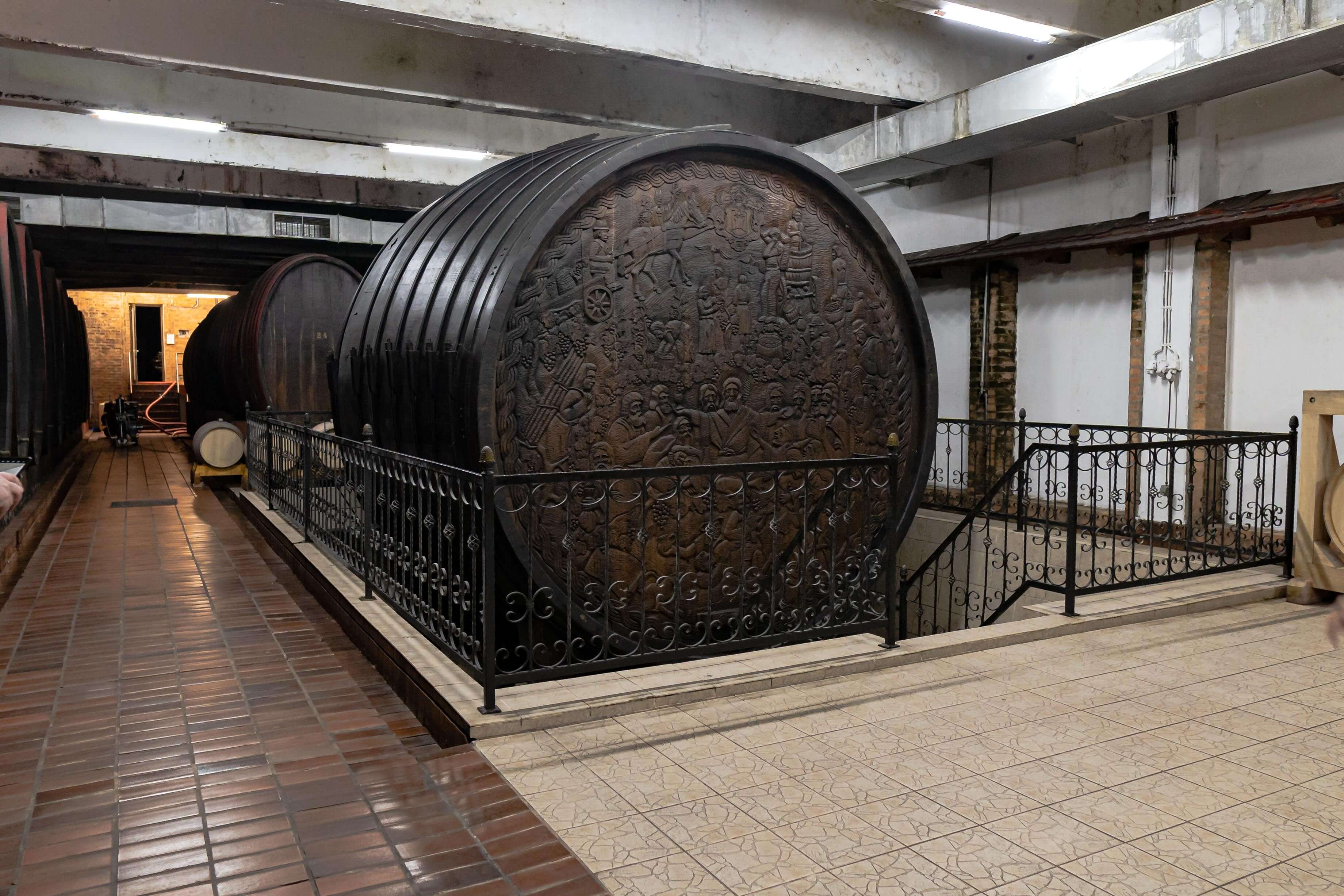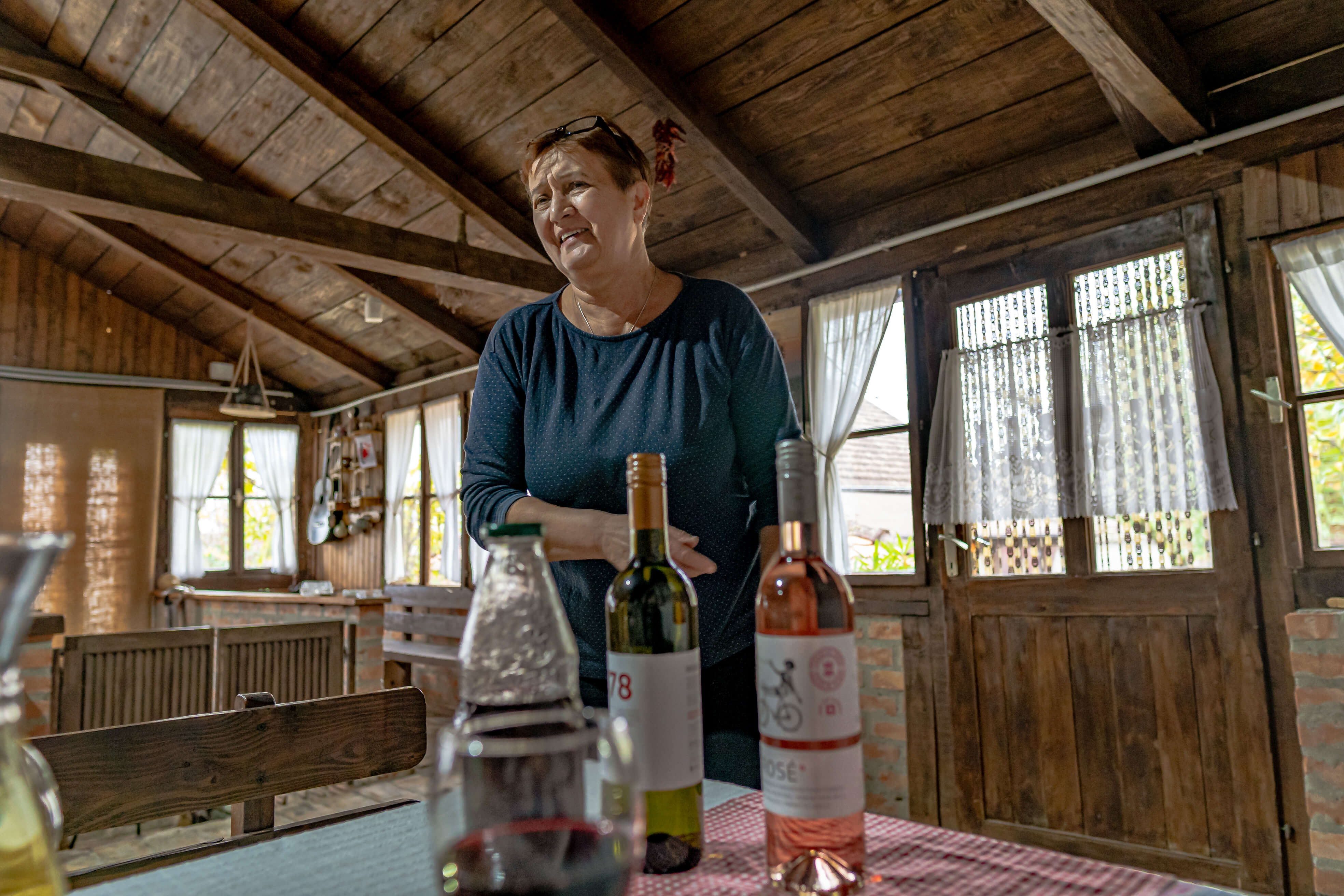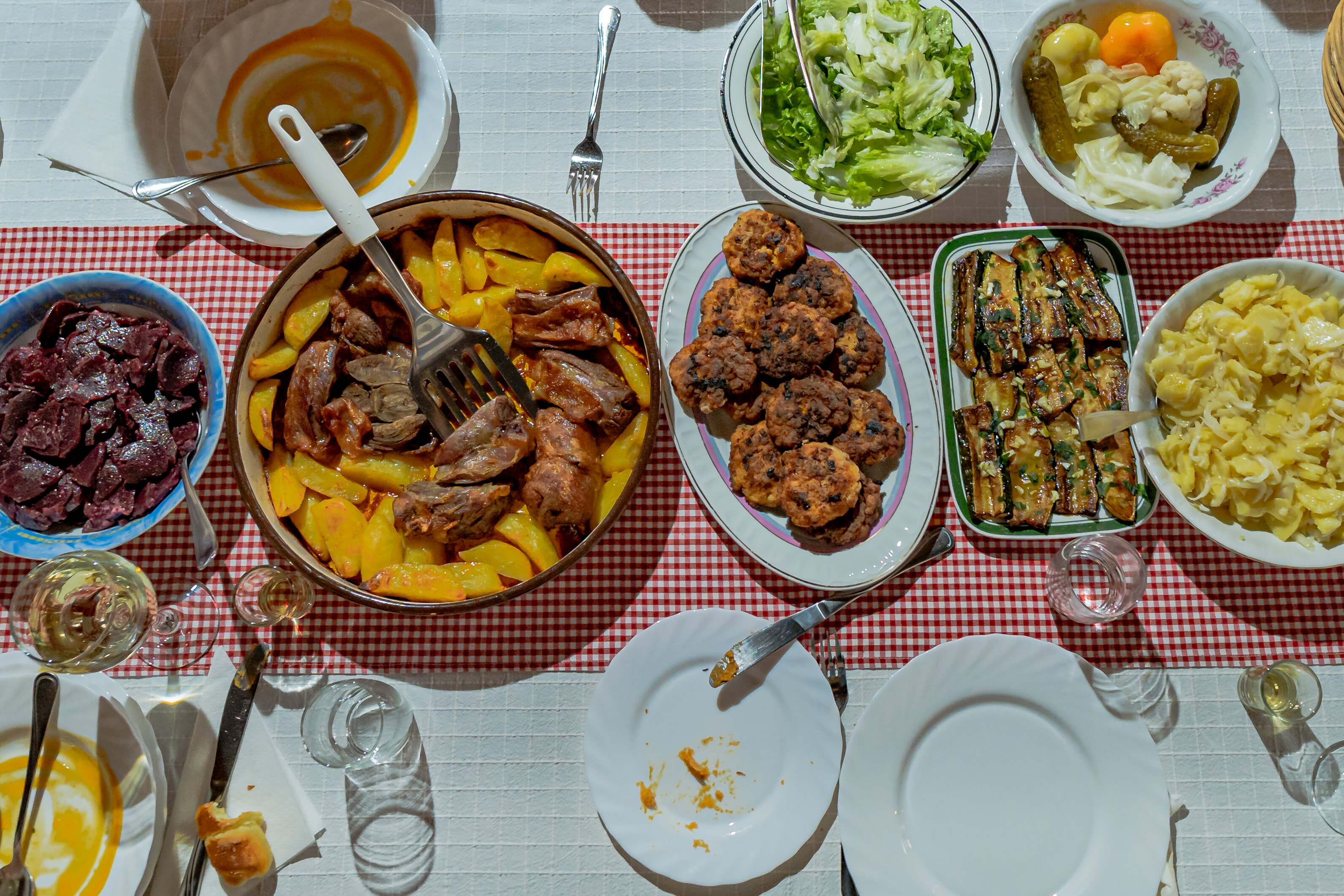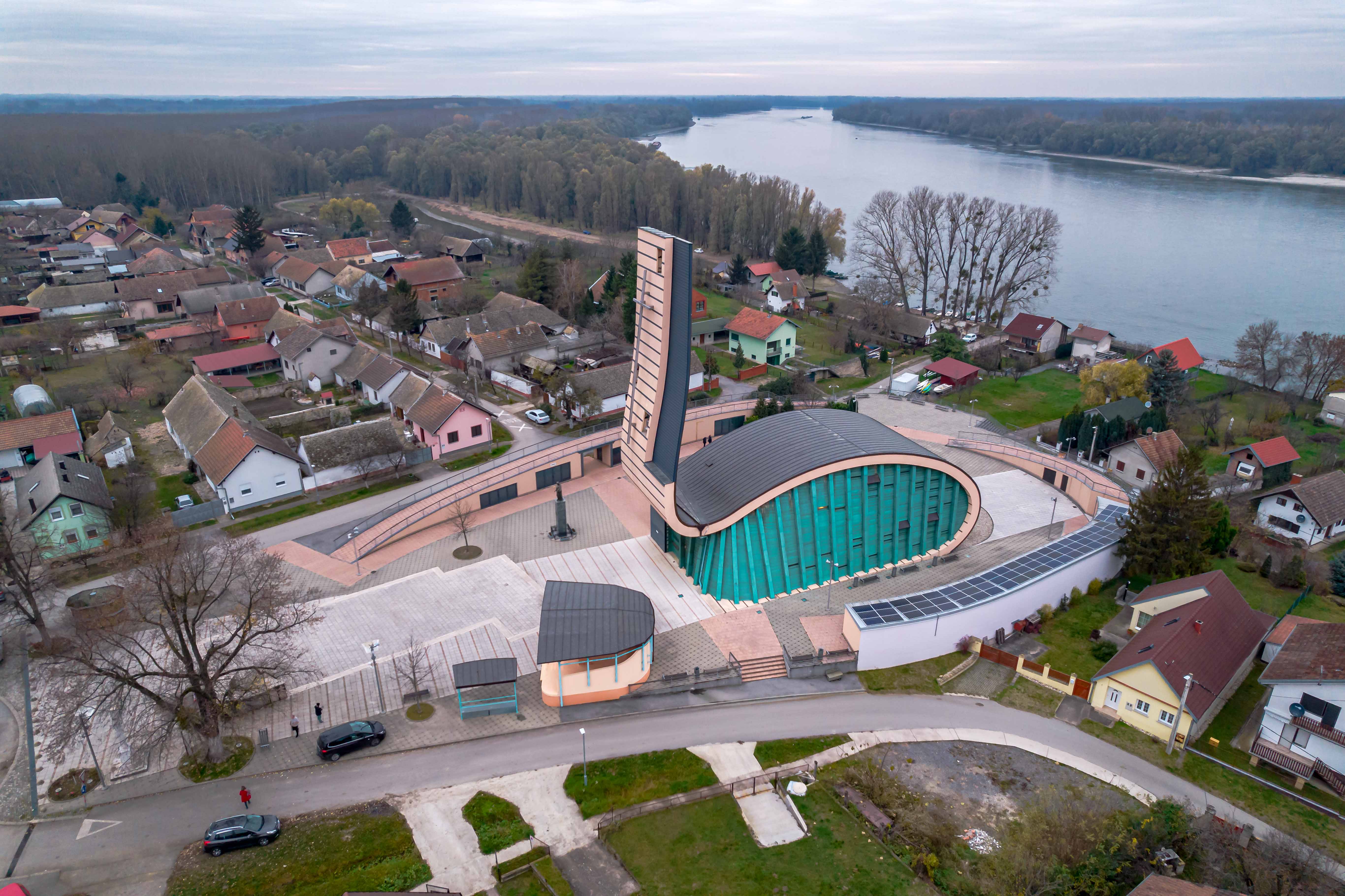Discover the Croatian Danube: SOM (Catfish) on Our Way to Šarengrad
December 3, 2022 – Having passed through Vukovar, the Croatian Danube continues its journey east toward Ilok. We reach the slopes of Fruška Gora, which is positioned just above the picturesque little villages, helping the river frame them.
When my family moved back to Vukovar in 1999, there was not a lot to do. Shops and playrooms weren’t really a thing, and my brother and I (4 and 6) spent most of our time outside. Hanging around the Danube in the summer, making snowmen in the winter. Year after year.
From time to time, we would get into the car to go on a family field trip. These special occasions were filled with laughter and excitement because the road would always surprise us anew. My dad would speed up on the little hills, making us feel like we were riding a rollercoaster and there was something to learn between them. We saw our first hazelnut trees, learned the difference between apple and pear trees, and we could even tell apart different kinds of crops. And the grapevines were always so much fun to look at. They stretched so far and wide that it felt like we were racing them.

The road follows the course of the Danube, and it leads to Šarengrad. That’s where the Danube kisses the sky, as sung by Josipa Lisac. And between Vukovar and Šarengrad came our first fish – som (Croatian for catfish). SOM stood for Sotin, Opatovac, and Mohovo, and it was a mnemonic taught to my mom by her father, who spent all his free time fishing in the Danube. To make sure that you get the villages in the correct order. When I was six, I thought it was the coolest wordplay ever; then, I thought it was kinda lame; now I’m sure that I’ll take my kids on the same road trip and teach them the same trick. In the newest edition of our Croatian Danube series, we will discover Sotin, Opatovac, Mohovo (som), and Šarengrad.
Sotin
- Sotin is a tiny village adjacent to Vukovar, with a population of about 700. Sadly, during the homeland war, as much as 10% of Sotin’s population was either killed or taken away, and many have not yet been found. That is why the first thing that you see in Sotin will be a monument dedicated to those people and their sacrifice. And though the village is relatively small, its location right next to Vukovar and on the crossroads of some other villages from the direction of Ilok makes it a convenient stop for refreshments.
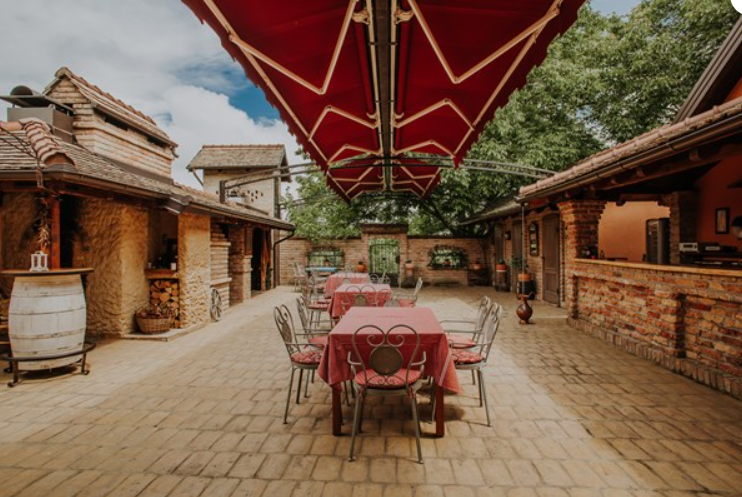
Vukovar Tourist Board
If you’re looking to have a drink or a bite of delicious local dishes, make a stop in Gondola Sotin. Gondola is a family run picnic ground and restaurant, with a few rooms available as well. The whole place is decorated with traditional patterns of Syrmia, telling the story of this beautiful area. In addition to daily operations, they host events, celebrations, and more, so it could be a good choice for a team building as well.
Opatovac
In Opatovac there’s a church, a small shop, a lake, and an internationally successful ping-pongng team. This even smaller village counts roughly three hundred people these days. Its residents will tell you there’s nothing to do, yet they spend most of their time hanging out in their little village. The first written recordings of its existence date as far back as 1387, when it was the home to a monastery. The reason why people settled there was its rich soil, which to this day remains one of the most fruitful areas in all of Europe.
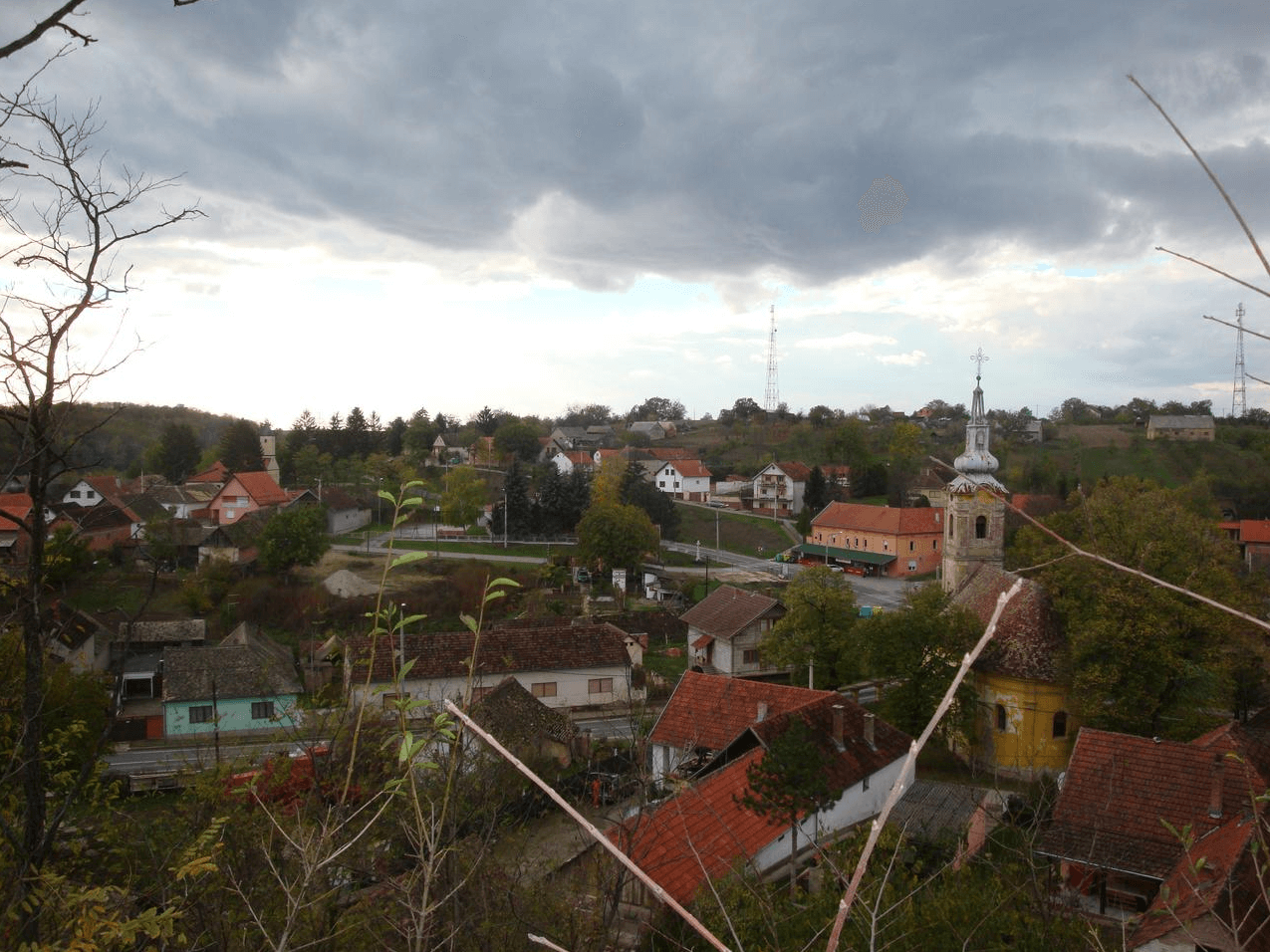
Lovas Municipality
Opatovac is the ideal place to rest, recharge, and wander around in nature. The most appreciated location in the village, especially if you visit in the summer, is undoubtedly the Opatovac Ada. On this river island, all locals and some visitors like to go swimming, camping, or just chilling in the shade. The volleyball tournaments that happen here are an experience in themselves. We would like to thank Andrija Pole for the pleasant conversation about his home village.

Mohovo
Welcome to the Mammoth Valley! Similar to Opatovac in size, Mohovo hides own little secrets. Though it only has about three hundred residents, they do know how to come together and show off their piece of paradise to the world. Thanks to Goran Popović and the association Dolina Mamuta (Mammoth Valley), the village is well on its way to becoming known as an epic place where remains of prehistoric animals can be found. So far, multiple mammoth teth and rhinoceros remains have been found right there.
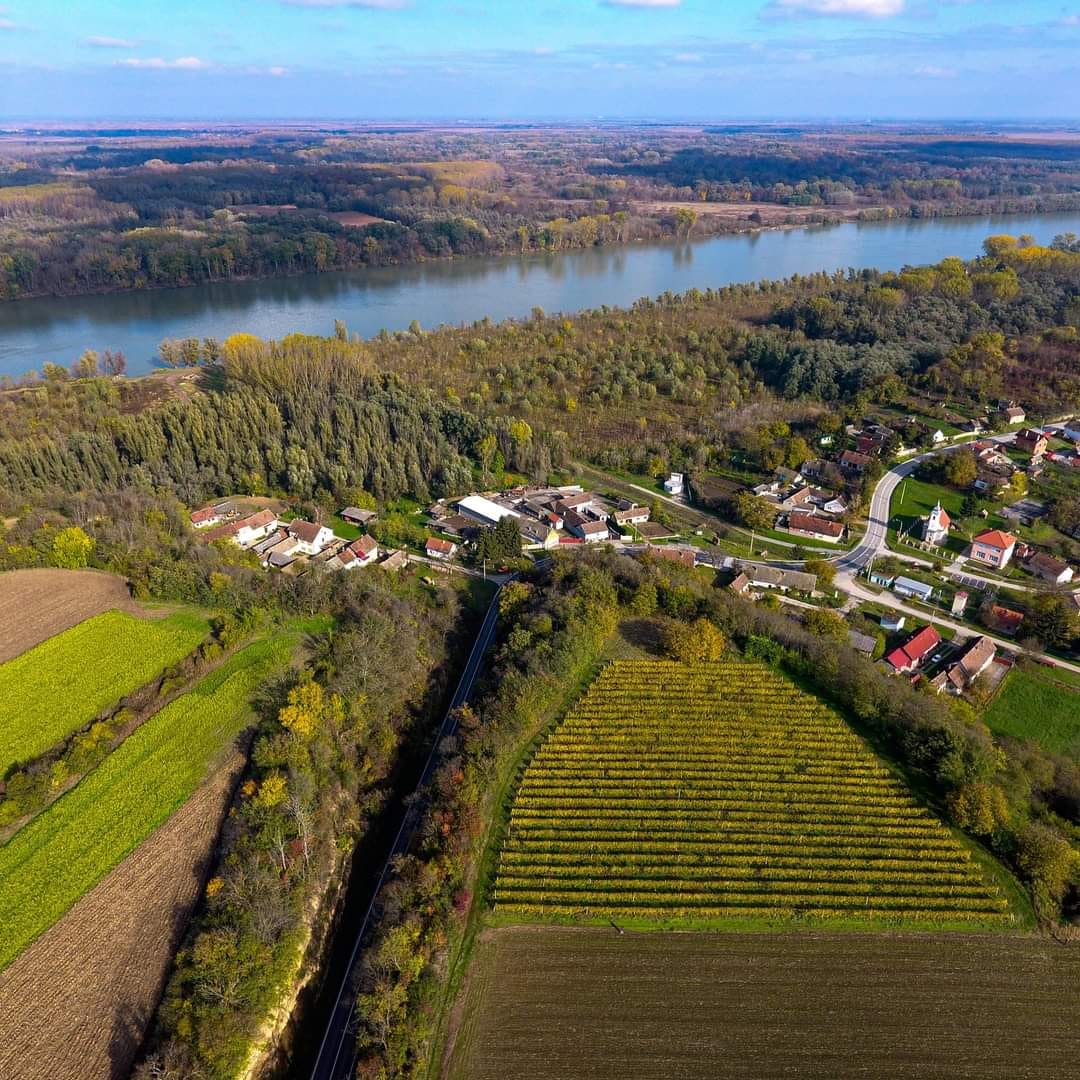
Udruga Dolina Mamuta FB
So far, the association has ensured that the remains were arranged into an exhibition, hosted two Mammothfests, and has put up educational materials around the valley for all visitors to learn along. In addition to promoting their history, the association regularly organises events for the village residents, like Fišijada (fish stew cook-off), the upcoming Christmas market, and more. Mohovo is the perfect little place to feel the spirit of community.

Udruga Dolina Mamuta FB
Šarengrad
Last, but not least, we have arrived in Šarengrad. The arrival there feels like you’re entering a fairytale -you are high on a hill, you can see the remains of a fortress on your left, a little settlement on your right, and the Danube framing it just below. Oh, and there’s a giant sign saying “Gdje Dunav ljubi nebo” (Where the Danube kisses the sky). And you know that it’s right here as soon as you see it.
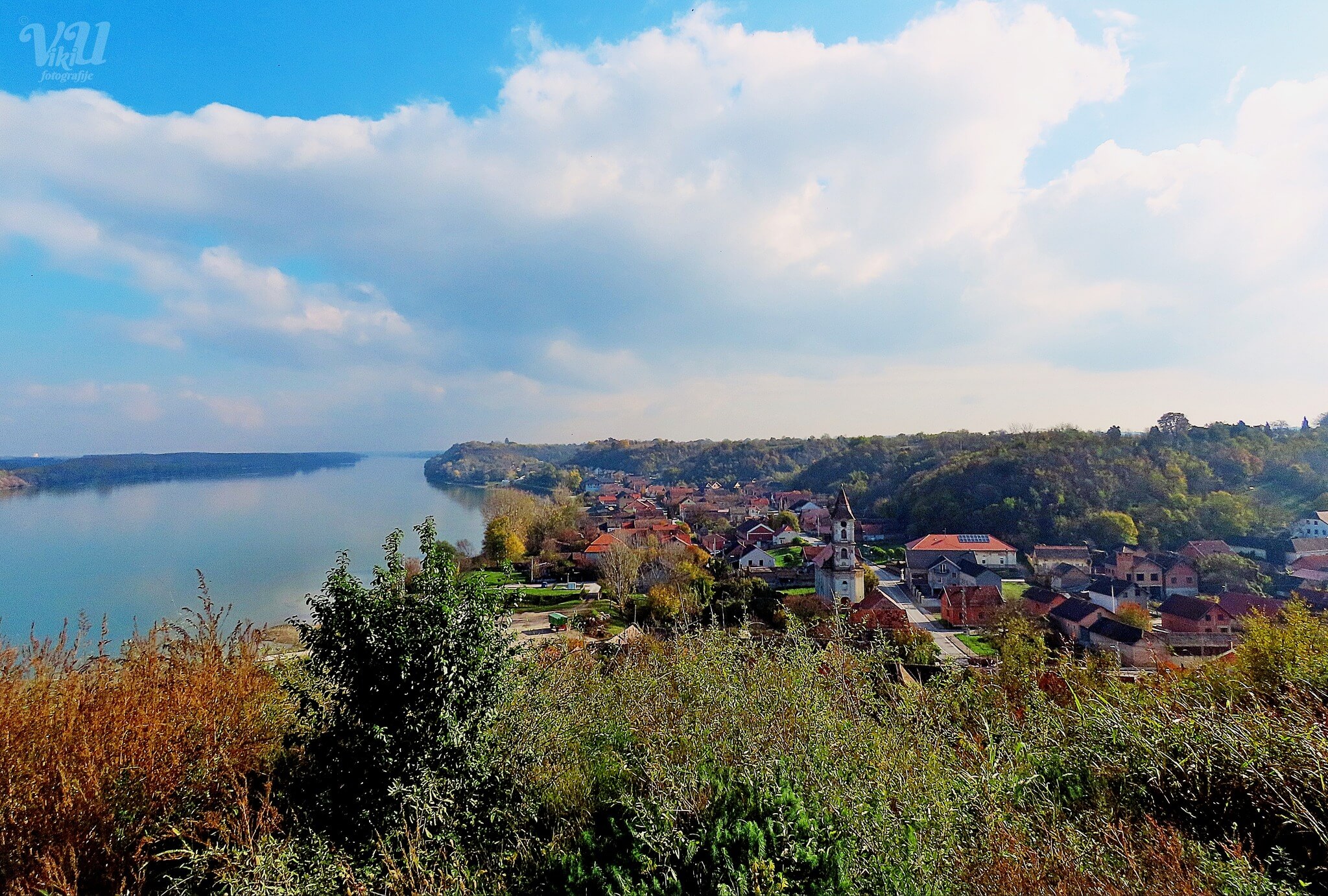 Violeta Kovačević - Viki Vu Fotografije
Violeta Kovačević - Viki Vu Fotografije
That is the perfect description of Šarengrad. The remains of the fortress date back to the 15th century, and there was info that the village might even date back to the 11th century. The village is slightly bigger than its neighbours, with some eight hundred residents, but it is still on its path of recovery. There might not be much to do there, but a day of exploring the fortress and hiking the bank of the river in perfect peace is all the escape that one might need. And though Šarengrad does not mean the colourful city like we thought when we were kids (in Croatian šaren = colourful), but is just a Hungarian word for Syrmia, the colours of Šarengrad in the spring or in autumn will leave you speechless. That’s a promise.
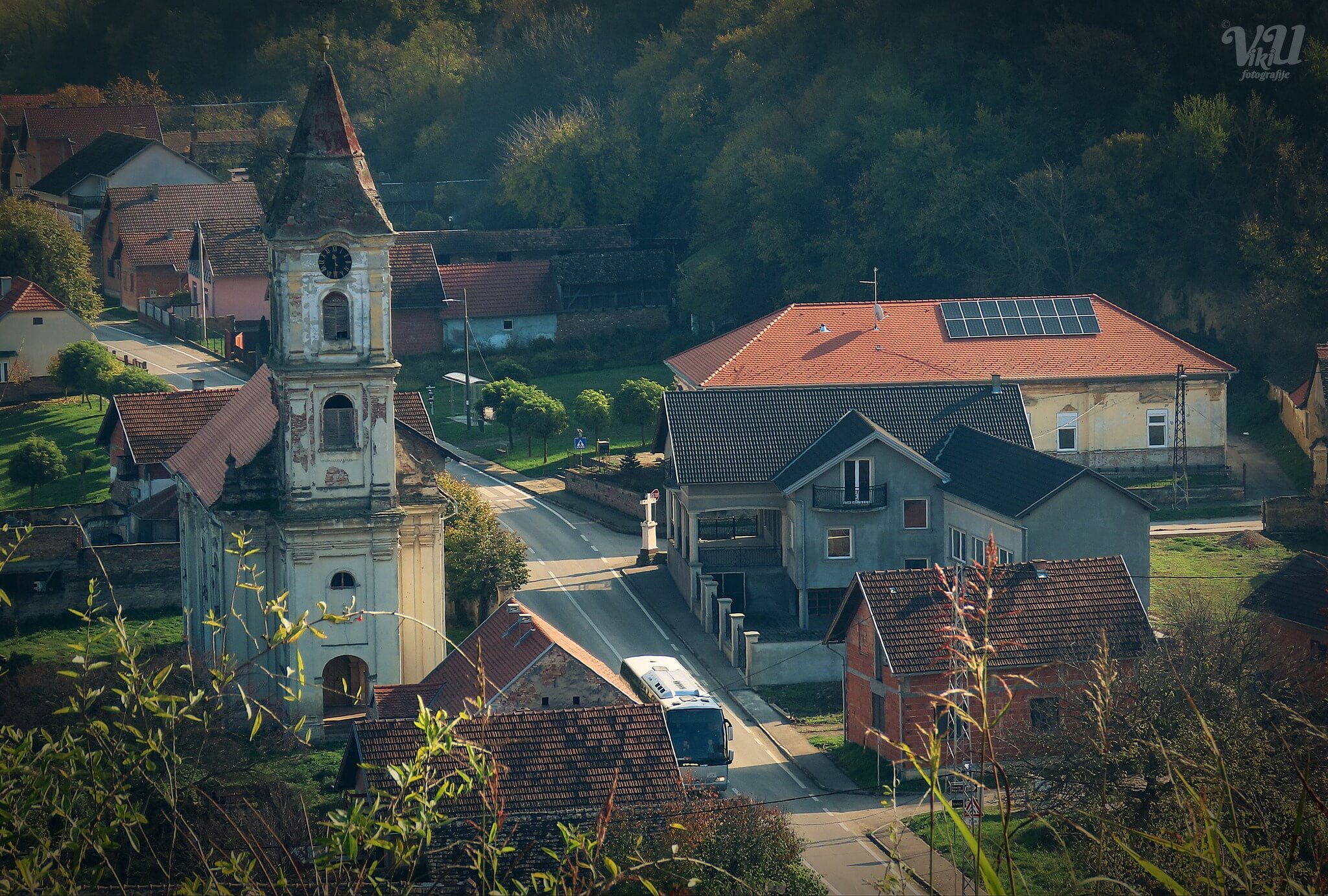
Violeta Kovačević - Viki Vu Fotografije
Discover the Croatian Danube with us and check out Aljmaš part 1 and part 2, Erdut, Dalj and Milutin Milankovic, and Vukovar. Stay tuned for the finale of the series – Ilok.
How good is your knowledge of eastern Croatia? Take the CROMADS test above - how many places do you recognise?
For more, make sure to check out our dedicated Travel section.
Discover the Croatian Danube: Synergy Between People and Grapes in Erdut
September 7, 2022 – Picture this. You took a weekend off and spent it in nature, fishing, camping by the Danube, and eating delicious fish stew. It would be silly to stop there, wouldn’t it? Nothing better to round it all up than more homemade food and outstanding wine. Balance it out with some physical activity. Head east from Aljmaš, follow the 11-kilometre-long promenade and you will arrive in Erdut. Located 37 kilometres from Osijek, you might have heard of it in the context of the Erdut Peace Agreement of 1995, otherwise an unknown place. If you just scratch the surface, though, you will discover a lot. We’ll start you off by telling you about its mystery, wine, and its people.
Historically, Erdut has been a calm small town where cultures intertwined. It was first mentioned in 1335 as Erdöd, and with the status of a town in 1472 as Castellum Erdeed. The name originates from a Hungarian word denoting a forest path or road. From the 15th century until World War II, it was passed from hand to hand between noble families. Among them were the Adamović Cseh family, whose 19th-century manor still stands in the centre of town. The manor is not the only piece of architecture worth visiting.
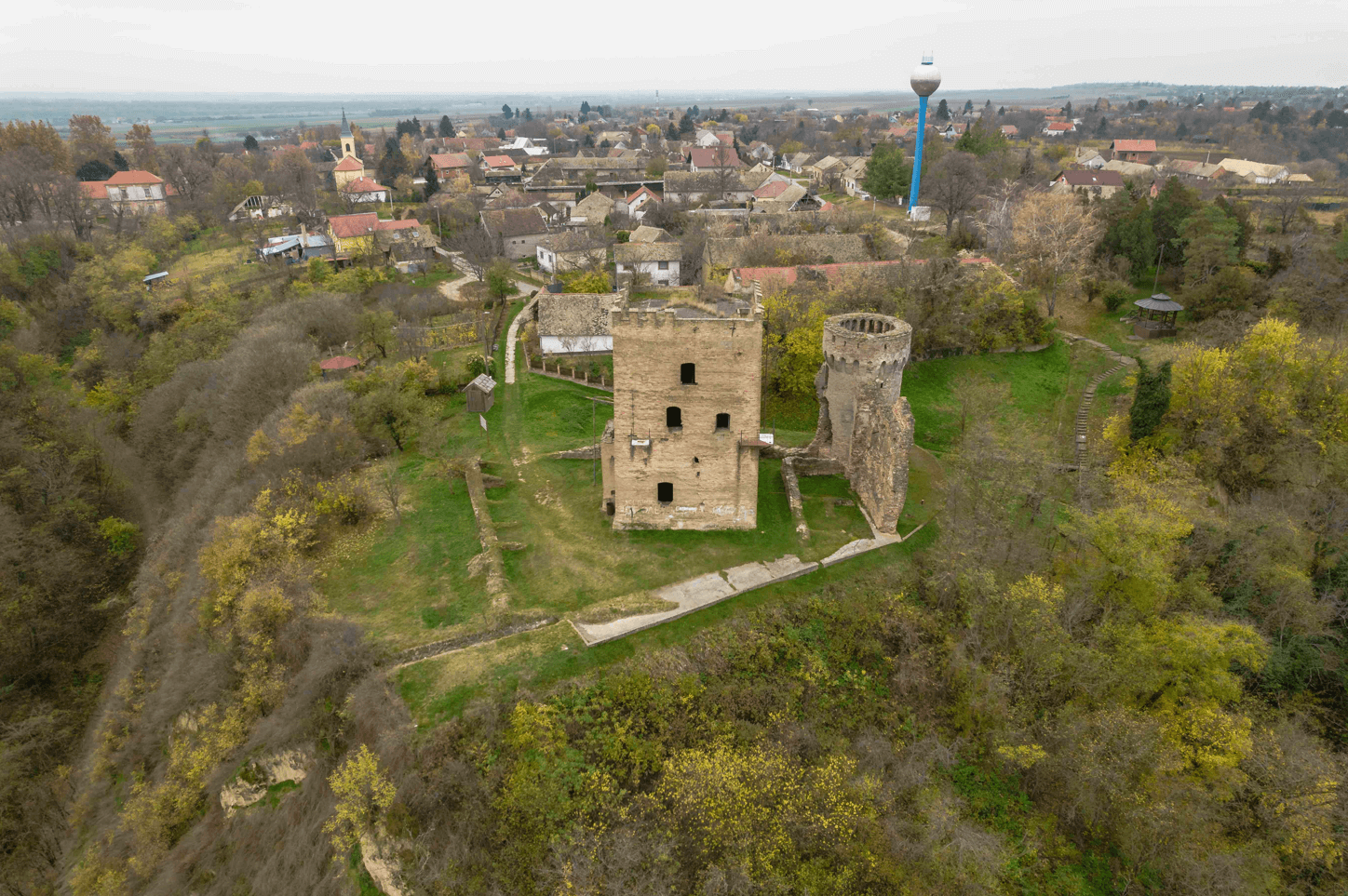
A mysterious medieval-looking castle stands on the bank of the Danube. There is no written information on its origins, but there are a few legends surrounding it. Each generation probably comes up with its own stories. Nada Bućkalović wrote about one of them where fairies would keep destroying at night whatever the builders would build during the day. To get them to stop doing that, they had to sacrifice a breastfeeding mother by building her into one of the pillars of the castle. According to Nada, the memories of the legend were refreshed when the grave in the basement was robbed. The pillar at the entrance was damaged, revealing a 180 cm tall skeleton, with a 150 cm long braid. Nowadays, the castle is a zero-category monument standing on top of a hill right next to the Danube. Local rock climbing associations like using it for practice, but you don’t have to be an expert to climb up the hill and explore its old walls. The Stairway of Health in the park right next to the castle will also take you up and down for a refreshing walk by the Danube.

Having touched on movement, this is the perfect opportunity to remind you of Erdut’s traditional Wine & Bike Tour. Usually taking place right in the middle of autumn grape harvests, this event attracts hundreds of visitors each year, all looking for good fun, healthy competition, and, of course, excellent local wine. Thanks to its geographical position, the Erdut municipality is famous for its vineyards, which stretch as far as the eye can see.
Erdut alone is home to multiple wineries, harvesting the famous Traminac, Graševina, Chardonnay, Riesling, etc. Graševina is the trademark wine of Erdut, and there is so much of it there that they had to build the world’s largest barrel to keep it all.
An incredible 2,5 tonnes of iron keeps the wooden construction in place. It has been listed in the Guinness Book of World Records, and it can keep 75 thousand litres of wine, equaling 100 thousand bottles! It was made in 1989 by DIK Đurđenovac, using the traditional method of construction with a total of 109 oak trunks which were by that point over 100 years old. The motifs of the traditional Croatian interlace and the Last Supper were carved by Naïve sculptors Tijardović and Fodor. The barrel has been kept full of Graševina ever since its construction. Not that its integrity is ever to be doubted, but it has been placed over a specially constructed pool that would salvage the gold-coloured nectar of life in case the barrel ever started leaking.
A day of sightseeing, cycling, walking, and wine tasting will surely make you quite hungry. Worry not! Though there is no restaurant in Erdut, the locals will be more than happy to feed you homegrown and homemade local food full of flavour, protein and healthy* fat, vitamins, and all the other nutrients your body and soul might need. One of them is teta Zlatica.
She is the perfect representative of what happens when you’re born and raised in a place like Erdut. Like many others in Slavonia, her family has faced all kinds of adversity during the Homeland war, and was left without a penny or a house. After going off into the world and becoming and successfully running a couple of businesses, her heart eventually took her back to Erdut to rebuild her family home and live off the land on the picturesque hills. She has decided to leave everything else and do what she does best and enjoys the most – open her home, her kitchen, and her heart to the curious wanderers who come to explore and experience Erdut. She is one of the residents in Erdut whose happiness is contagious. They all work together, driving change and inspiring progress. It is this synergy (along with their wine) that we believe will get them far and make you feel right at home.
She runs Etno Kuća Stari Dud, where she provides accommodation and freshly cooked meals. If you visit at the right time, live traditional music nights might spontaneously happen. So far, she has hosted team buildings, theatre groups, and events like birthdays and christenings. If you would like to give her a visit, e-mail This email address is being protected from spambots. You need JavaScript enabled to view it. and we’ll sort you out in no time.
*might not always be extremely healthy
Photos: Steve Tsentserentsky
How good is your knowledge of eastern Croatia? Take the CROMADS test above - how many places do you recognise?
For more, make sure to check out our dedicated Lifestyle section.
Interreg Connecting Cruise 2022: Replica of Roman Ship Sails into Vukovar
September 5, 2022 – Even though the summer is not yet completely gone, and many tourists are still spending their days at the beautiful beaches of the Adriatic Sea, September is a special month all around Croatia. In Vukovar, a replica of a Roman ship sails in on Tuesday the 6th of September to tell stories of the Roman times.
With events popping up left and right, celebrating wine, movement, food, art, and a lot more, you will find something to do wherever you go. Among them, the coast of the Danube and Vukovar shine yet again to show that eastern Slavonia is, in fact, full of life 365 days a year.
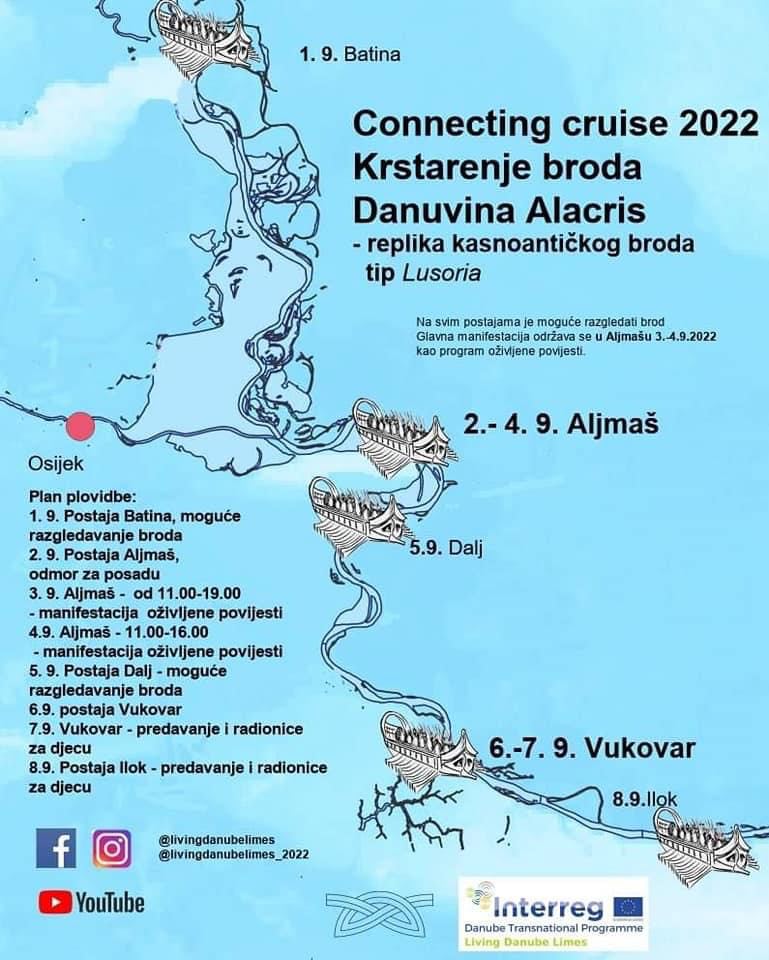
Interreg: The ship's route and programme
As part of the international Interreg project Living Danube Limes, on Tuesday, September 6, 2022, a replica of a Roman ship from the 4th century will sail into Vukovar. The ship started its journey on the Danube Limes on July 15, 2022, in Germany, and after having sailed through Austria, Slovakia and Hungary, it arrived in Croatia. The crew, made up of international volunteers, has sailed to Batina, Aljmaš, and Dalj in Croatia on the way to Vukovar, and after a two-day stay in Vukovar, the ship will continue its journey towards Ilok and further down the Danube to the Black Sea. The Croatian partner of the project is the Institute of Archaeology, which, together with the City Museum of Vukovar and the Vučedol Culture Museum, participated in the organisation of this event in Vukovar.

Vukovar Municipal Museum: The programme in Vukovar - the arrival of the ship on Tuesday, educational workshops, lectures, and a pub quiz on Wednesday
On this occasion, the Vukovar Municipal Museum prepared various content for all ages, from workshops for children and adults, and lectures on the topic of making a ship replica to a museum pub quiz. It should be pointed out that the replica of the ship will be available for viewing by all interested visitors on both days. They invite all citizens to join in and experience the atmosphere of the Roman era in the 21st century.
For more, make sure to check out our dedicated Lifestyle section.
Swimming For All, Now Surfing: A Wild Boar Spotted on the Danube
September 3, 2022 - You’ve seen tourists of all nationalities, you have even seen a deer swimming in the Adriatic. Move over everyone, wild boars have got places to be. The summer might be on its way out, and the humans and animals visiting the Adriatic coast are enjoying the final weeks of sunny beach days. The Adriatic is not the only body of water where you can have some fun, though. It has never occurred to us before, but is looks like the Danube might be good for surfing. At least this wild boar thinks so.
And it is not only the Croatian Danube that hides many gems. This time in Serbia, in Belgrade, a wild boar went surfing on what looked like a wooden board. As reported by Espreso, the pictures were taken by random passers-by and shared on Facebook in the group Beograd bez maske (Belgrade without a mask). It was then shared on Reddit, in r/AnimalsBeingGeniuses, by u/djukanovics27. Head on there for some random Saturday entertainment.
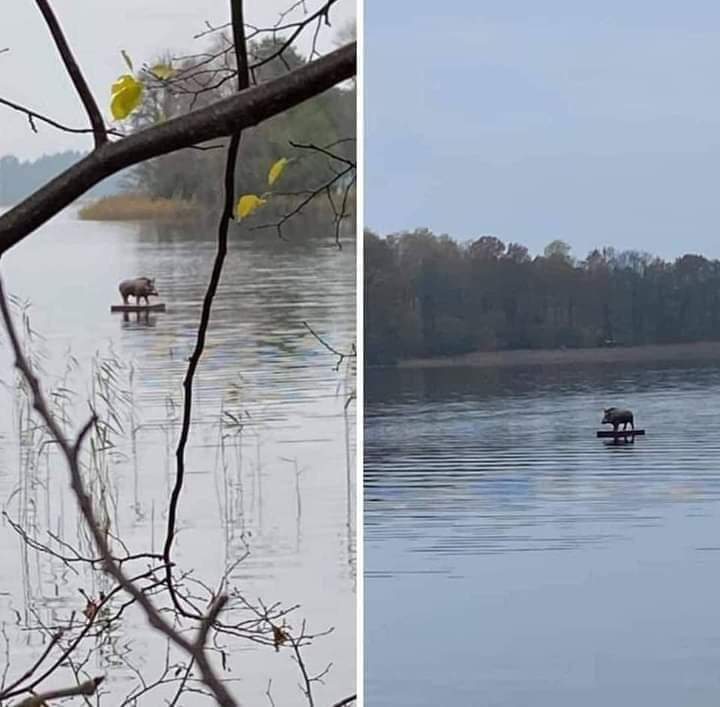
Facebook Group Beograd bez maske
So boars are turning out to be fairly interesting with a diverse range of interests. With the ability to swim for up to 12 hours straight, this beneficial physical activity seems to be quite high on the scale of their preferences. One even made a lengthy journey from Brač to Split.
Last, but not least, as previously written on TCN, a deer was spotted going for a dip in the Adriatic, at the Pokonji Dol beach on Hvar. It ran down the beach, tested the water, and jumped in for a plunge! It was a hot day, after all.
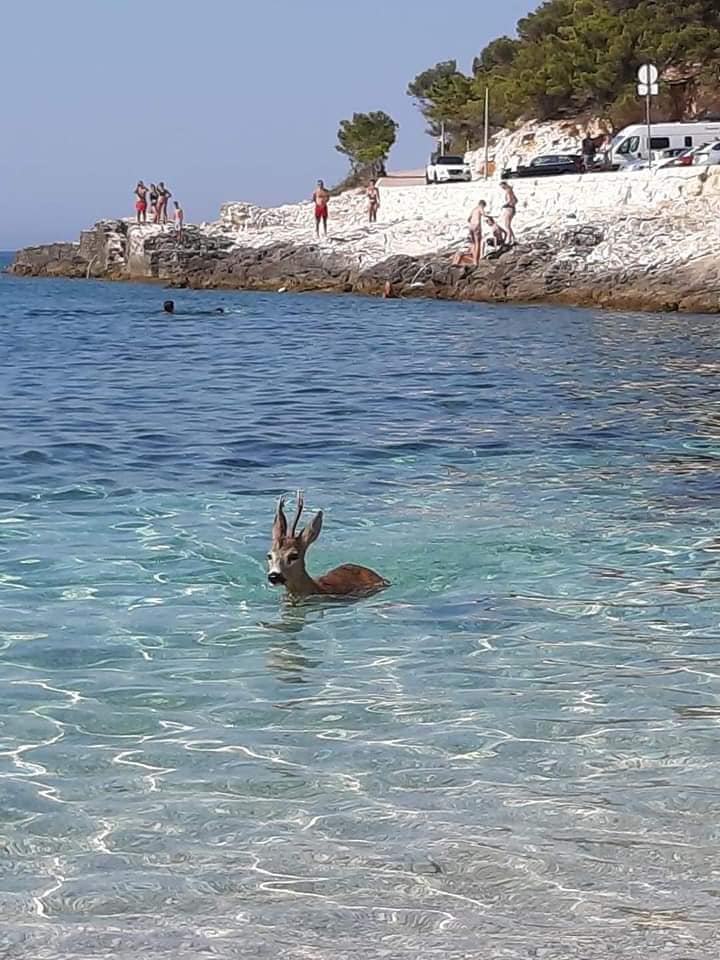
Nada Kordic Bezic
Who knows, maybe this is the dawn of a brand new series on TCN? Stay tuned.
In the meantime, for more, make sure to check out our dedicated Lifestyle section.
Discover the Croatian Danube: Fishing Village of Aljmaš (Part 1)
August 15, 2022 – The blue, the mighty, the grand, the Danube. One of the most important rivers in the world that was the lifeline of an entire civilisation in Vučedol remains an aspect of life without which life would be unimaginable everywhere along its course. The German, the Austrian, and the Hungarian Danube are well known. It is time to discover the Croatian Danube. From Osijek to Ilok, its course is adorned with picturesque little villages. In part one of the series, welcome to Aljmaš.
Located some twenty-six kilometres east of Osijek and the same distance north of Vukovar, between the slopes of Alma Mons, or Fruška Gora, and the bank of the Danube, this small fishing village patiently awaits the arrival of all who seek peace and quiet. Four streets, a thousand or so houses, one big church, some 350 people. Is that all there is? Of course not. Hundreds of years of history, legends, traditions, and the best fish stew you would ever hope to try. An easy, quiet lifestyle with all that you might need. Even business opportunities.

Photo: Dubravka Petric (PIXSELL)
It has been 785 years since the first mention of the name Aljmaš. The area itself, though, has hosted life since long before, and the locals keep finding remains of Roman architecture to this day. With its geographical position in proximity to the river, the settlement surely played an important role in the Roman empire. A theory excitedly discussed among the locals is that a yet-to-be-located battle between the Romans and the Illyrians might have happened in the valley of Aljmaš itself.
The historical importance of the village also lies in the fact that the well-known Hungarian humanist and poet Janus Panonnius was born in none other than Aljmaš. Though Čazma was previously believed to be his birthplace, his verses confirm that it was indeed “Where the Drava surrounds its name and water to the Danube”. And during the Austro-Hungarian rule, it was the beloved summer garden of Maria Theresa.
As for other popular sources of debate, there is an interesting theory that explores the possibility that Novi Sad in Serbia was built by settlers from Aljmaš, somewhat resembling the New Amsterdam story. In the early 18th century, when the plague was the main threat in Europe, a group of people from Aljmaš apparently sailed out on a raft down the Danube to escape the disease. They might have settled some 130 km east, around the area of today’s Novi Sad. To confirm this theory, the locals point out that the streets of Aljmaš were called sadovi, which is an old Slavic word for garden, and the name Novi Sad, you guessed it, means a new garden. Secondly, Novi Sad, the city is only about three hundred years old, which would correspond to the time of movement.
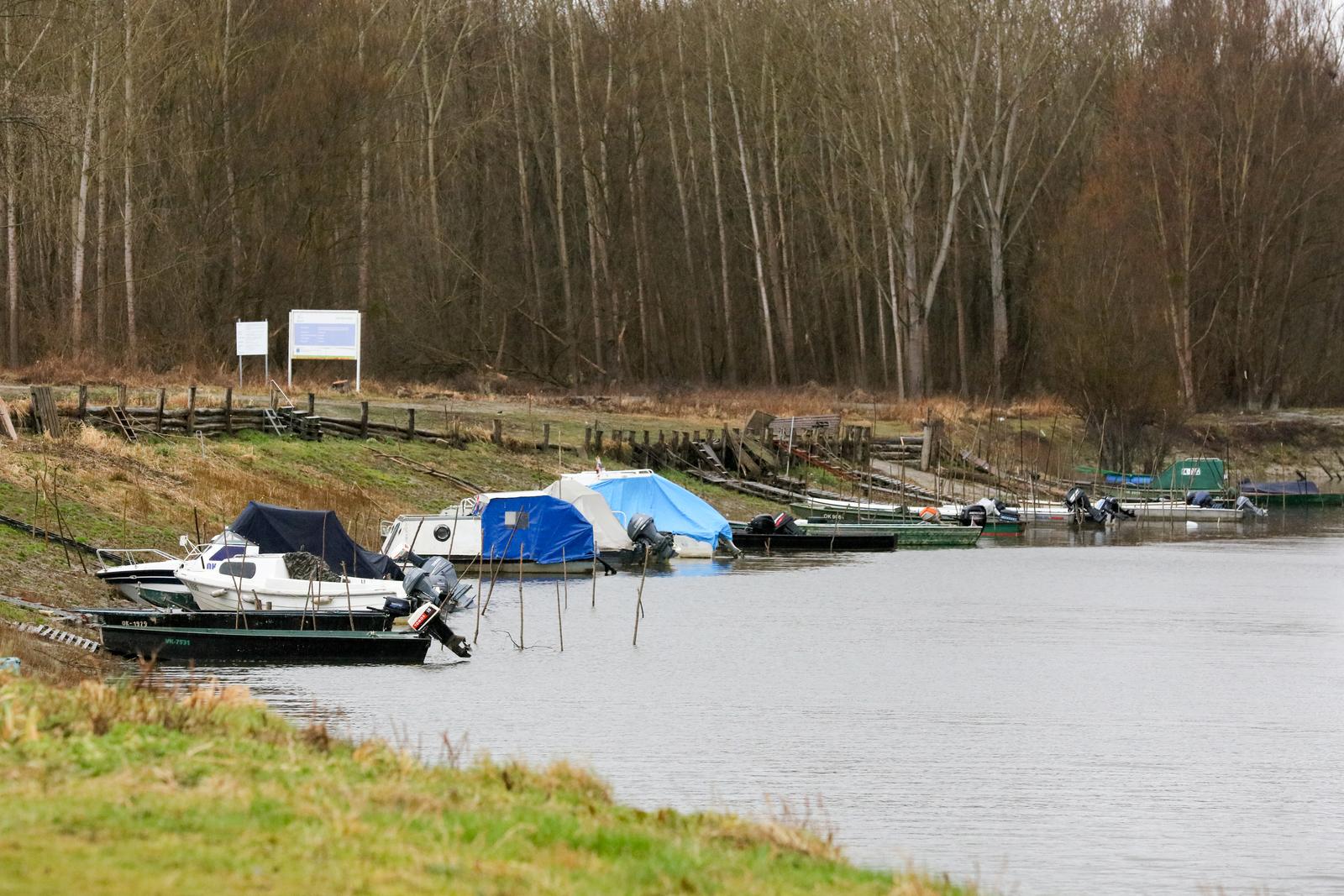
Photo: Dubravka Petric (PIXSELL)
Modern Aljmaš lived its golden age between the two world wars, when 1446 people lived there, who owned 46 businesses, and the village had 2 butchers and 3 bakeries. It was an important port on the way from the Black Sea to Budapest, which, as you can imagine, ensured that the birth rate would steadily grow. It was also an important weekend and summer home for the nobles of Osijek and Vukovar who needed a quiet place in nature, especially those who liked fishing. After the second world war, as well as the Homeland war, the population of Aljmaš unfortunately significantly declined, leaving it at approximately a quarter of what it used to be.
It is, however, slowly being rediscovered. Trying to escape a busy hectic lifestyle, many will naturally gravitate towards picturesque little places like this to spend their holidays, weekends, or retirement, but people have also started permanently moving there to live a relaxed life and raise their children in a safe environment where nature still dictates the way of life.
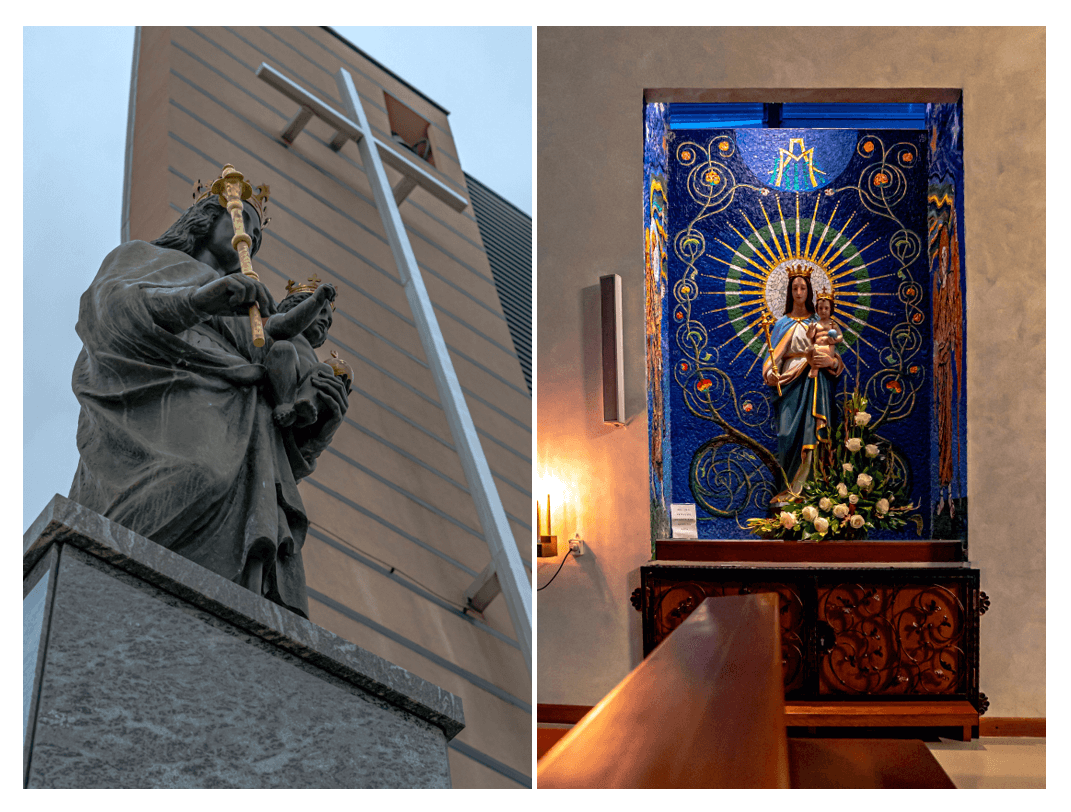
Photos: Steve Tsentserensky
Catholicism has always played a very important role here, so much so that even during the Ottoman rule when many were forced to convert to Islam, Aljmaš remained a Catholic settlement. Nowadays, it is one of the famous places of worship and pilgrimage in the name of Mary. Even though a legend does exist of a sighting of the Virgin Mary, the reason why Aljmaš became her home is different. In 1704, a statue of Mary was brought from the village of Lug in Baranja to save it from the rebellion that was brewing there against the Habsburg monarchy. A humble little church made of branches and mud stood in Aljmaš to provide shelter. Mary has been the symbol of Aljmaš ever since. In 1846 the village church burnt down, along with the statue, only leaving a painting of the former statue. A new baroque church was built, and the bishop Josip Juraj Strossmayer financed a new statue to be made in Vienna. During the Homeland war in 1991, the said church was heavily bombarded and taken down, and the statue was believed to be destroyed. In 1992, however, a Russian UN soldier found the statue with only the crown and a part of one arm missing, dressed it in his vest, and put a helmet on it to conceal it and safely transport it to Osijek. Just like the people of Aljmaš, it spent years in exile. It remained in Osijek until 1998 when it was taken back to Aljmaš. The road, of course, was the Danube. It was taken on a boat, with hundreds of fishing boats following.
Photo: Steve Tsentserensky
With the old church destroyed and the statue of Mary having been returned to Aljmaš, the local government decided to invest in a new place for worship and built the new, monumental church in 2003. It is famous for its architecture, but this does spark debate among the locals. While some think that its modern design draws people in, others disagree since its architectural integrity might not be the best, and it is questionable how long the church will withstand the humidity and the winds from the Danube.
One thing is for sure, though. The church is still an important place not only for the residents of Aljmaš but for many who visit to pray and contemplate. Without a doubt, the most important date remains today, August 15, marking the Assumption of Mary. Year after year, the holy mass in the open gathers thousands of pilgrims. Though it is a quiet celebration, the village comes alive in its former glory with people walking, talking, praying, and the children all gathering around the little stalls for ice cream, cotton candy, or plastic toys.
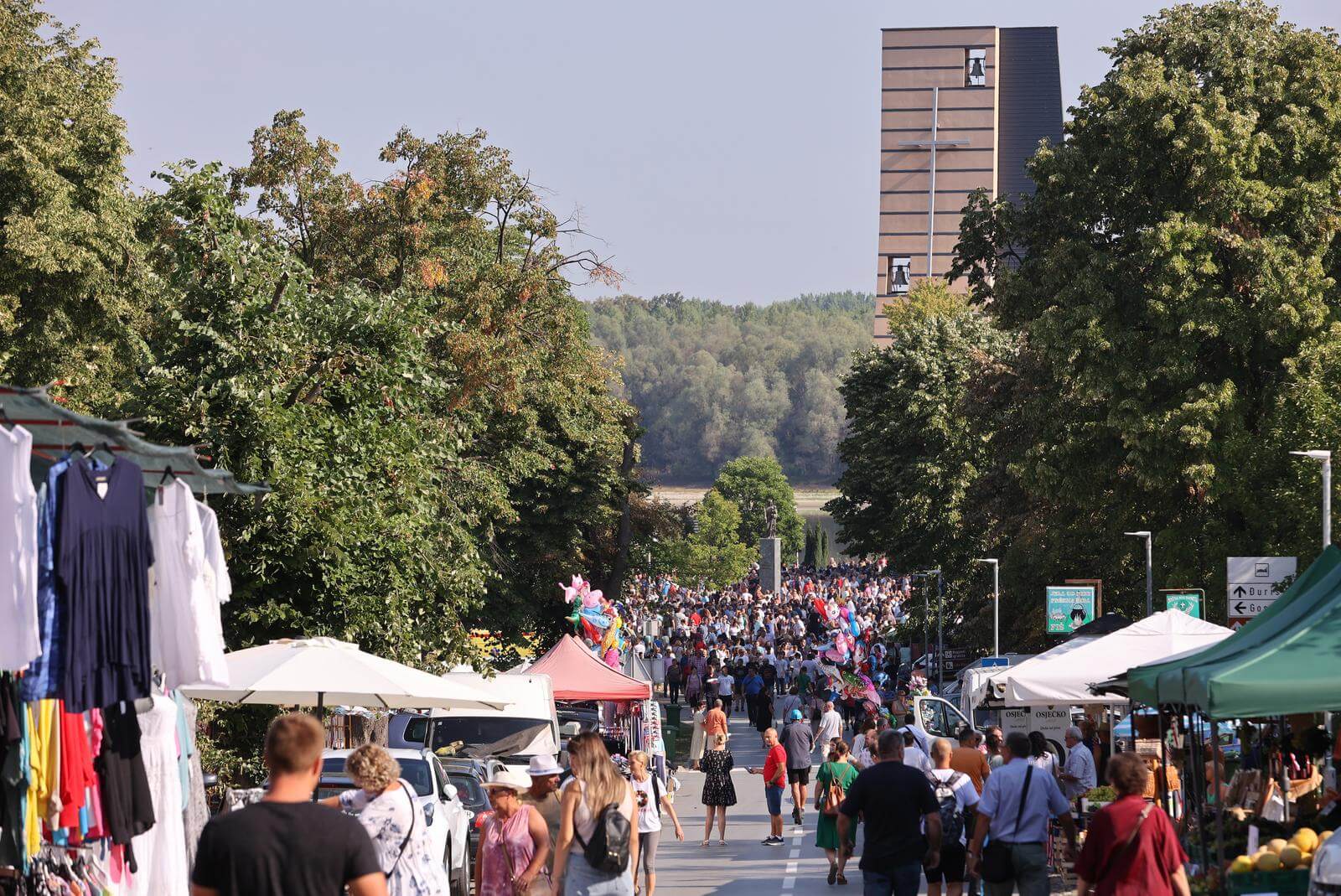
Photo: Davor Javorovic (PIXSELL)
Even though August 15 remains the most important day for Aljmaš, it is not the only day when something happens. The locals gathered in cultural societies make sure that the traditions keep on living, and that daily life is still eventful. To find out more about the local customs and traditions which live on, how the village Google makes sure they know it all, why foreigners keep buying houses there, and when you should make sure you visit, stay tuned for part 2 next week on TCN.
Special thanks to Marina, a tourist guide from Aljmaš, who works hard to keep tradition alive and who happily shared her stories with TCN.
How good is your knowledge of eastern Croatia? Take the CROMADS test above - how many places do you recognise?
For more, make sure to check out our dedicated Lifestyle section.
Croatia Part of UNESCO Mura-Drava-Danube Biosphere Reserve Crossing 5 Countries
September 16, 2021 - The UNESCO-declared Mura-Drava-Danube biosphere reserve is the first in the world to cross over five countries - Austria, Slovenia, Croatia, Hungary, and Serbia.
On Wednesday, UNESCO declared the Mura, Drava, and Danube area the world's first five-state biosphere reserve. The largest protected river area in Europe is an excellent example of cooperation between the five countries. The biosphere reserve stretches across Austria, Slovenia, Croatia, Hungary, and Serbia to almost a million hectares and 700 kilometers of river flow, reports HRTurizam.
Recall, the joint nomination of the five countries was sent to UNESCO in September 2019, and it was the last step of the puzzle to declare the Mura-Drava-Danube the world's first five-state biosphere reserve. Due to its unique habitats and numerous rare species, the biosphere reserve is also known as the European Amazon.
The biosphere reserve area abounds in rare habitats such as large floodplain forests, sand and gravel banks, steep banks, and backwaters. They are home to the largest population of bald eagles in Europe and the nesting ground of many endangered bird species such as sand martin, little terns and black storks, beaver and otter habitats, and fish such as sturgeon.
About a million people depend on the Mura, Drava, and Danube, and these three rivers have shaped their lives. Floodplains protect settlements from floods and supply drinking water, while exceptional river landscapes increase the potential for sustainable tourism development.
"Cross-border nomination is a strong indicator of strengthening regional cooperation and unification of countries with a unique goal of nature protection. Working on a joint nomination is an excellent example of interstate cooperation on such an important issue," said Petra Remeta, director of the WWF Adria nature protection program back in 2019.
The value was also recognized by the European Union, which co-financed projects worth more than 20 million euros, which contribute to the protection of nature and the development of this area.
For more on travel in Croatia, follow TCN's dedicated page.
Cultural Identity of Vukovar: New Book Presented in Vukovar
June 9, 2021 - The fascinating question of the Cultural Identity of Vukovar is researched in a new book edited by Dr. Mateo Žanić and Petar Elez. However, as the editors stressed in the introduction, further research is needed to encompass all social groups in Vukovar and their contribution to the heritage of Vukovar.
After being published back in April this year, the book „Cultural Identity of Vukovar – Contribution to Investigating Heritage and Successors“, was presented this Wednesday in Vukovar. As Ivo Pilar Social Research Institute writes on its website the book was published in cooperation with the Vukovar State Archive, so it was only suitable that the first book presentation was held in Vukovar at the videoconference hall of College Of Applied Sciences „Lavoslav Ružička“ (named after a famous Croatian chemist whose work is awarded a Nobel Prize). In addition, the event marked International Archive Day.
The book was edited by Dr. Mateo Žanić and Petar Elez, and the presentation, alongside editors, saw scientific experts Dr. Dražen Živić, Mirela Hutinec, and Dr. Domagoj Tomas talks about the book.
„Fast events triggered by globalization process and information revolution which paradoxically lead to today's societies being fiercely occupied with the meaning of past, and preserving its valuable traces. In that context, there is a spreading interest for heritage that holds an important component to understand the relationship between the past and present“, says the editorial introduction of the book.
The editors went on to explain how „the city proved to be futile to interpret the meaning of heritage and its contribution to cultural identity,“ and the editors wanted to present various aspects of Vukovar's cultural heritage.
Apart from editors Žanić (who wrote a chapter „Layers of memories and material heritage in modern-day Vukovar) and Elez (author of the chapter „State archive in Vukovar and development of archive service in Vukovar-Srijem County“), the book features eight more authors. Ivan Rogić (Whose Heritage? Who is the successor?), Dražen Živić (on Vukovar's feudalists), Vlasta Novinc („Danube, food, Corso“), Dragana Drašković (on the cultural life of Borovo Selo), and more by Dragan Damjanović, Toni Roca, Ivana Bendra and Ivan Hubalek.
With these broad presentations of culture and heritage in Vukovar, editors hope this book will encourage further research as they are aware this is certainly not the final word on these interesting questions and issues.
„As editors, we are aware that the book does not deal with topics that concern different social groups that left their trace in Vukovar end enrich the history of the city. We hope that future editions that will deal with this topic expand the reach of issues and help us to realize better what do we inherit from the past and why is that important“, concludes the introduction of the book.
So far, the book is available only in Croatian, and research that will, as editors say, deal with other social groups in Vukovar is yet to come. Keeping in mind the terrible aftermaths of the war in Vukovar in the 90s and inter-ethnic tensions, further findings on joint cultural contribution to Vukovar may indeed be the enlightenment needed for peaceful cohabitation and development of Vukovar as a perspective city in Croatia.
Speaking of heritage, learn more about UNESCO recognized heritage in Croatia on our TC page.
For more about science in Croatia, follow TCN's dedicated page.
Two Croatian Projects Among Finalists for European Natura 2000 Award
September 8, 2020 - The European Commission has announced the finalists of the European Natura 2000 Award for 2020.
The Natura 2000 network is formed of 27,800 sites and ensures the survival of Europe's invaluable and threatened species and habitats. The Natura 2000 Award thus rewards excellence in the management of these sites and highlights the value of the network for local economies.
Among the 27 finalists this year are two projects with Croatian partners, which will compete in five categories.
Namely, LENA - Local Economy and Nature Conservation in the Danube region, received 295 votes to become a finalist.
"WWF Bulgaria, in partnership with 12 other organisations, led this initiative aimed at addressing the economic difficulties and depopulation linked to unemployment in the lower reaches of the Danube region as part of the Interreg project LENA.
The overall objective was to find ways of creating new nature-based business initiatives and to share know-how and experience on sustainable economic development in 15 Natura 2000 sites in six EU countries and one neighbouring country: Bulgaria, Croatia, Germany, Hungary, Romania, Slovenia and Serbia. Over 1 100 small and medium-sized enterprises (SMEs) were involved in the initiative. Wild plant collectors, fishermen and farmers were trained and given assistance in adding value to their businesses.
A refrigeration showcase was purchased to support the local trade in fresh products in Bulgaria. 169 participants engaged in capacity-building workshops on sustainable wild plant collection in four countries according to the FairWild certification. Links between harvesters, traders and processors were established and a business plan for a wild plant purchasing point was made in Ivanovo, Bulgaria.
Certificates for products from three protected areas were introduced (for Slavonian pigs in the Dunav-Vukovar Natura 2000 Site in Croatia, non-GMO products in future Natura 2000 sites in Serbia, and local agricultural products in the Comana Natura 2000 site, Romania). 225 local and national authorities were involved in policy workshops, and four guidance documents and recommendations for better policy support of green jobs were distributed to stakeholders. Around 280 000 tourists and locals from Natura 2000 sites were made aware of the importance of the sites and nature-based jobs.
Sustainable forms of tourism, such as rural, cultural and culinary tourism, were supported through the establishment of a network of Danube guides represented by each country (Germany, Croatia, Slovenia, Serbia, Romania and Bulgaria). Currently, the network has 100 trained guides in six countries, a protected logo and a website (https://danube-guides.net/). Building on the success of the project, an additional network has been launched on E-mobility– with E-stations, E-bikes and E-managers. A policy framework for green jobs was also supported," reads the description on the EU Natura 2000 website.
ECO KARST - For Nature and For People, received 566 votes.
"Led by the Slovenia Forest Service in partnership with 11 organisations from nine countries (Slovenia, Croatia, Austria, Germany, Hungary, Romania, Montenegro, Serbia and Bosnia Herzegovina), the Interreg-funded ECO KARST project aimed to address one of the main challenges in nature conservation, namely bridging the gap between the needs of biodiversity preservation and the improvement of the livelihoods of local populations.
To do this, the project brought together seven protected areas – so-called karst bio-regions - from across the Danube Region to find ways of generating and supporting new socio-economic opportunities that are in keeping with the extremely fragile karstic Natura 2000 habitats (e.g., intermittent lakes, beech forests, wet and dry meadows) and that are based on their valued ecosystem services.
The first step was to map all the ecosystem services generated by the karst habitats in these seven Natura 2000 sites. 57 maps (eight per pilot area) were produced in total and then analysed, in close collaboration with local stakeholders, to identify areas that could become Biodiversity Investment Opportunities (BIO). The 23 BIO maps were used in turn to prepare Local Action Plans, in which each protected area aimed to combine the necessary conservation guidelines with the potential for local, sustainable, and nature-friendly economic development.
These Action Plans have since been integrated into official park management plans and other relevant documents in each of the parks, to ensure that locals and nature are brought closer together and where possible are mutually supportive. The Action Plans include some 146 new measures (21 per protected area) that are of common interest to both park authorities and local stakeholders, with shared responsibilities.
The project also sought to actively encourage new socio-economic activities in the sites and therefore launched a call for Pro-Biodiversity Businesses (PBBs). In total, 70 entrepreneurs responded to the PBB award calls, and 23 were awarded support. These are businesses that create profits, without harming nature or even by actively conserving it. PBBs represent a concrete and viable option for achieving sustainable development within European protected areas and the entire Natura 2000 network.
Together, the Action Plans and PBBs have been a vital step in bridging the gap between the needs of biodiversity preservation and the improvement of the livelihoods of local populations," says EU Natura 2000 on its website.
You can read more about the Natura 2000 finalists HERE.
For the latest travel info, bookmark our main travel info article, which is updated daily.
Read the Croatian Travel Update in your language - now available in 24 languages
French Magazine 'Le Figaro' Falls in Love with Slavonia
August 13, 2019 - Slavonia is in the French spotlight!
One of France's most influential media outlets, the Le Figaro Magazine, published a major 10-page report on Slavonia in its weekly issue. The report was prepared by Jean-Louis Tremblais, a journalist and lover of Croatia, in collaboration with Eric Martin, one of the most respected French photographers, reports HRTurizam.
In September last year, the duo, organized by the Croatian National Tourist Board, stayed in Osijek-Baranja and Vukovar-Srijem counties, and their "Slavonian experiences" were translated into a sizeable photographic report entitled "On the Borders of Croatia. A Terrace on the Danube."
In the published report, which will be seen by millions of potential French tourists, Slavonia was named an open-air museum that will delight lovers of untouched nature and cultural heritage, as well as those attracted by undiscovered landscapes away from the tourist bustle and well-known destinations. "From gourmets to lovers of history, wine, horses and nature, Slavonia is an undiscovered corner of Europe for guests of exquisite taste," the influential French weekly revealed.
The report follows the breeding of Lipizzaners, which is part of the UNESCO list of Intangible Cultural Heritage, and mentioned traditional manifestations cultivated in Slavonia, such as Vinkovci Autumn, which retains authenticity and is a rarity in the tourist destinations of today. This historic region is also presented as a gastronomic paradise for lovers of local specialties such as kulen and various wine varieties such as traminac and graševina.
A separate section of the report entitled "Hedonistic and Cultural Escape from Everyday Life" provides a detailed overview of the most attractive restaurants, hotels, parks and museums to visit. During their stay in Slavonia, Tremblais and Martin visited many other tourist attractions such as Kopački rit, the ethno-village of Karanac, the Vučedol Culture Museum, the cathedral in Đakovo and others.
HTZ points out that filming the 90-minute well-known culinary show "Cuisine Impossible", which was initiated by the Croatian National Tourist Board and in cooperation with representative offices and local communities, was recently completed in June this year in Vukovar-Srijem County, in which the art of preparing fish stew will be presented to the French audience.
Thus, during the first seven months, 315,000 arrivals and 1.1 million overnight stays were recorded by French tourists, which represents a growth of 7 percent in arrivals and 6 percent in overnight stays compared to the same period last year.
In July, however, 136,000 arrivals and 530,000 overnight stays were recorded, which represents a 10 percent growth in arrivals and overnight stays compared to July last year.
You can find the Le Figaro spread on Slavonia here.
To read more about travel in Croatia, follow TCN’s dedicated page.
Croatia Attending Meeting of Danube Countries
ZAGREB, June 28, 2019 - A two-day forum of the Danube River Basin countries started in Bucharest on Thursday, with speakers at the event saying that the EU's cohesion policy, which helps reduce differences between the EU's rich and poor member-countries, was a foundation of prosperity.
Addressing the event, European Regional Policy Commissioner Corina Cretu expressed hope that debates and other activities at the forum would help encourage prosperity in the Danube region.
We cannot secure better living standards for citizens across the EU without putting our identities together and demonstrating solidarity, she said.
Attending the forum were representatives of 14 countries through which the Danube passes or into which its basin extends, and where 112 million people live, which is around 20% of the EU population.
The European Commission in 2010 adopted a strategy for the Danube region as part of which it finances joint projects of nine member-countries and five countries that are still not members.
One of those projects concerns joint crisis management in cases of natural disasters such as floods.
This forum is an opportunity for countries that are not EU members to sit at the same table with EU member-countries, Cretu said, adding that this was an added value of the Danube strategy.
The attending representatives from Austria, Bulgaria, the Czech Republic, Croatia, Germany, Hungary, Slovakia, Slovenia and Romania as well as Bosnia and Herzegovina, Moldova, Montenegro, Serbia and Ukraine, discussed road construction, environmental protection, tourism, cultural cooperation and security.
The next forum of the Danube River countries, to be held in 2020, could be organised in Croatia which takes over the six-month presidency of the Council of the EU in January.
More Danube news can be found in the Lifestyle section.


